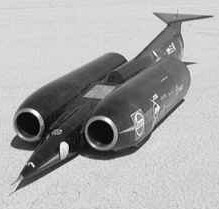ThrustSSC: 763 MPH
Today, a very fast car. The University of Houston's College of Engineering presents this series about the machines that make our civilization run, and the people whose ingenuity created them.
What's the fastest you've ever moved? You've flown at near sonic speed in high-altitude jet liners, but that offers no sense of speed. The ground's too far away to provide a frame of reference. The highest speed you've been aware of may well've been landing at the airport. At that instant you whip past objects on the ground at around 150 miles an hour. I've gone that fast in Japan's Shinkansen train, but never any faster on the ground.
A Stanley Steamer first reached 150 miles an hour in 1907. Since then, top ground speeds have doubled every thirty years, but only a handful of people have experienced those top speeds.
 Speeds got stuck just below the speed of sound in the early 1990s. The British, who took the record away from the American Breedlove in 1983, finally went supersonic in 1997. They did it in their ThrustSSC, with its driver's pod hunkered down between two huge turbojet engines. By now it's reached 763 miles an hour.
Speeds got stuck just below the speed of sound in the early 1990s. The British, who took the record away from the American Breedlove in 1983, finally went supersonic in 1997. They did it in their ThrustSSC, with its driver's pod hunkered down between two huge turbojet engines. By now it's reached 763 miles an hour.
The biggest problem the British faced was determining how shock waves would interact with the ground. At supersonic speeds, wind forces can blow a car about like tissue in a hurricane. If the car's the least bit unstable, the driver is a dead man.
You can't test such behavior in a wind tunnel, because you'd need a road moving past the stationary test vehicle at more than the speed of sound. Only in the last few years have supercomputers reached the capacity for making such complex airflow calculations. Only recently has it become possible to design such a car.
And there lies a great irony. The nuclear test ban treaty has given Los Alamos Laboratory a major impetus for developing such complex computations. They hope to reach the point where they can model nuclear blasts. By banning live tests, the treaty might well be contributing to the design of nuclear weapons, at the same time it's stimulating the development of new tools for racecar makers.
In any case, the British car went supersonic just fifty years and a day after Chuck Jaeger did it in an airplane. Then, on October 15, 1997, at Black Rock, Nevada, RAF squadron leader Andy Green pushed the car to Mach 1.02 (763 miles an hour) with his wheels turning at 8500 rpm. And he lived tell of it.
Moving that fast on land is dangerous beyond our comprehension. Indy 500 racecars go scarcely two hundred miles an hour. Insofar as speed is concerned, our automobiles reached their maturity in the late 1930s. A few years later, French philosopher Roland Barthes said,
... cars today are almost the exact equivalent of the great Gothic cathedrals: I mean the supreme creation of an era, conceived with passion by unknown artists, and consumed in image ... by a whole population.
While ThrustSSC outruns our jet planes, our motorcars really have become aging icons. We have consumed their image, but we've also frozen their speed ever since my childhood.
I'm John Lienhard, at the University of Houston, where we're interested in the way inventive minds work.
(Theme music)
Mach 1 on Earth. Aerospace. October 1998, pp. 12-16.
The Barthes quotation is from La Nouvelle Citroën. Mythologies, 1957.